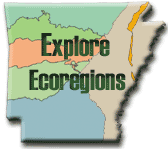
| Announcements |
| AWAP in the News |
| Executive Summary |
| Wildlife Action Plan |
| Database |
| Ecoregions |
| Grants |
| Project Reports |
| Legislative History |
| Resources |
| Partners |
| Home |
![]()
Steering Committee Meeting Summary
10-05-06
Attendees: Doug Zoellner, TNC
Allan Mueller, TNC
Bill Holimon, ANHC
Steve Osborne, FWS
Steve Filipek, AGFC
Betty Crump, USFS and AAS
Ken Smith, Audubon Arkansas
Brad Carner, AGFC
Ian Hope, AGFC
Kris Rutherford, AGFC
Jeff Holmes, Conservation Southeast, Inc.
Jane Anderson, AGFC
Handouts:
-
CWCS Steering Committee Agenda
-
Abundance And Distribution Of Fishes In Floodplain Wetlands Of The Arkansas River
-
Species And Habitat Projects Funded By SWG Prior To Oct. 2006
-
Strategic Outline For The Attention Impaired
-
Identifying And Prioritizing Annual Implementation Actions: A Strategic Outline
-
Priority List Of Projects Identified By Habitat And Taxa Association Teams
-
Arkansas River/Wetland project. David Goad, Assistant Director, introduced Bryan Day, Assistant City Manager, Mark Webre, City Parks engineer, and Wilson Tolefree, Director of Little Rocks Park and Recreation. They introduced an Arkansas River/Wetland project that would involve land in front of the AGFC Nature Center (under construction) and a downstream rectangular ten-acre dike field composed of dredged material from the Arkansas River Navigation Project. To be eligible for SWG funding, the project is required to benefit species of greatest conservation concern (handout 2). SWG Funding is not intended for educational or recreational aspects of projects.
David Goad asked us to assist the City in looking for ways to design this project to make it appropriate for SWG funding because of the benefits to public approval of the State Wildlife Action Plan goals. He also noted that grants management and project accounting are in the process of being reworked and that having a single project rather than several would be helpful to that process for this year.
Others noted that the project was worthy but perhaps inappropriate for this source of funding. Doug Zoellner of TNC noted that he often hears of mitigation offers for local projects and perhaps these could be useful.
-
CWCS update. Jane Anderson reported that the CWCS plan has been conditionally approved. Further work required in elements 5 and 6 prior to resubmittal before November 2. 2006. Funds for State Wildlife Grants appropriated for 2006 have not been budgeted except for ongoing projects. The following development of a procedure to prioritize projects is part of the requirements.
-
Procedure for project prioritization. The Steering Committee reviewed and revised the general procedure of prioritizing data gaps, monitoring and conservation to the following:
Categories of Implementation:
Data Gaps (baseline inventory, research)
Conservation Actions (protection, management, restoration, etc.)
Monitoring
Step 1: Populate CWCS database with best science available (AGFC and partners)
2005 (done), then ongoing
Step 2: Use CWCS database to generate a ranked implementation list based on weights and rankings assigned in Step 1 (AGFC)
2006 (done), then every 2 years
Step 3: Develop a draft 10-year implementation schedule (Taxa and Habitat Teams)
2006 (done), then revise every 2 years
Step 4: Identify and rank 2-year implementation priorities (Taxa and Habitat Teams to Steering Committee)
2006 (September 15, 2006), then every 2 years
Step 5: Recommend annual implementation priorities (Steering Committee to Implementation Team)
2006 (October 5, 2006), then annually
Step 6: Provide results of Step 5 to Steering Committee for review, then request proposals (Require monitoring element if applicable in each proposal). Provide list of pre-proposals with budgets to AGFC implementation team, which includes Assistant Director, Chief of Wildlife, Chief of Fisheries and two leadership level representatives from two other SWAP partners for final approval and to address budgeting.
January 2007, then annually (to work with AGFC budgeting cycle)
Step 7: Implementation strategies are revised on an ongoing basis as Conservation Actions, Data Gaps, and Monitoring issues are addressed.
Ongoing
Step 8: Every 10 years review and revise entire CWCS process as needed, from top to bottom, including database, protocols, fundamental logic, etc. (AGFC and partners)
Every 10 years beginning in 2015
-
The Steering Committee was asked to recommend annual implementation priorities - Step 5 in procedure above. These have been grouped by similar projects for the purpose of facilitating explanation to the implementation team and AGFC commissioners.
-
Ken Smith discussed a request for funding ($45K SWG share) to support Important Bird Area project proposed by Dan Scheiman. This is a continuance of ongoing work involving several team members. No vote was taken.
-
Meeting adjourned at 3:45 p.m.
![]()
Announcements |
AWAP in the News |
Executive Summary |
Wildlife Action Plan
Database |
Ecoregions |
Grants
|
Legislative History
|
Resources |
Partners |
Home
© 2005 Designing A Future For Arkansas Wildlife All Rights Reserved
